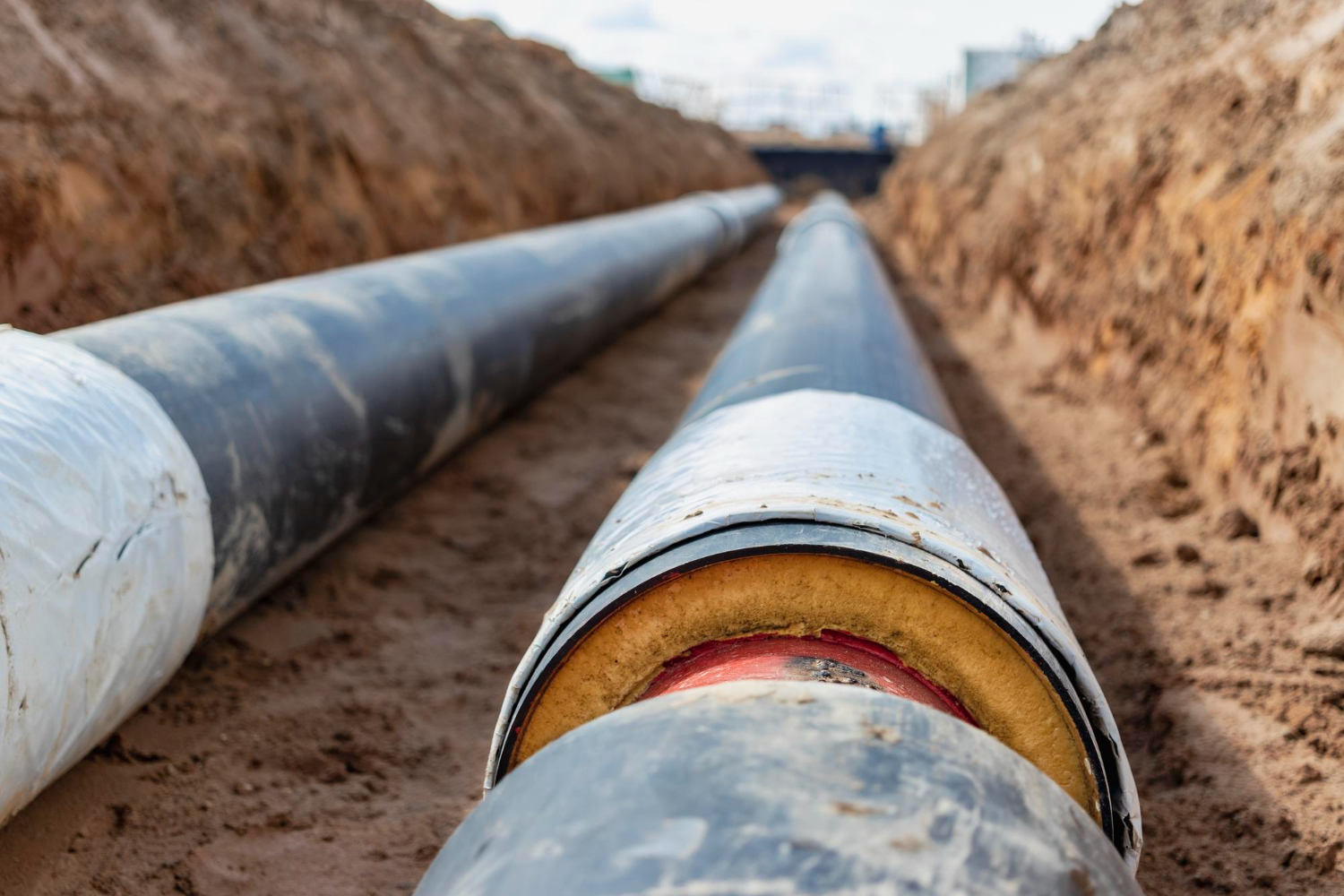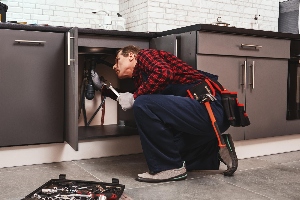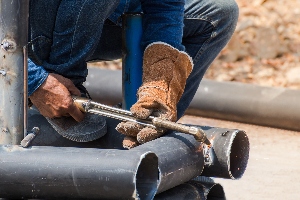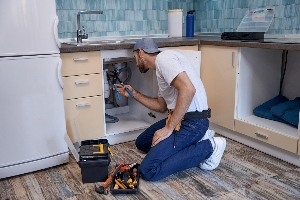A collapsed sewer line creates serious problems for homeowners, from sewage backups to water damage and health risks. The key to avoiding major damage is spotting the warning signs early, such as slow drains, foul odors, and soggy spots in your yard. When we catch these issues quickly, we can often prevent a full collapse and reduce repair costs.
Most homeowners don't think about their sewer line until something goes wrong. The main sewer line connects all the drains in your home to the city's sewer system. When this line fails, every toilet, sink, and drain in your house can stop working properly.
We'll walk you through the common causes of sewer line collapse and help you identify the warning signs before they become expensive emergencies.
Here’s what you need to know:
You'll also learn about modern repair options, typical costs, and steps we can take to prevent future problems with your sewer system.
What causes a sewer line to collapse
Several factors can cause your sewer line to fail completely. Age, environmental conditions, and blockages are the main culprits that lead to pipe collapse.
Common reasons for sewer pipe failure
Material breakdown is one of the top causes we see. Old clay pipes crack and crumble over time. Cast iron pipes rust from the inside out.
Ground shifting puts stress on underground pipes. Heavy rains can wash away soil support. Earthquakes and settling foundations create pressure that pipes cannot handle.
Heavy loads above ground can crush pipes below. Construction equipment, large trucks, or new buildings add weight that old pipes were not designed to support.
Poor installation leads to early failure. Pipes installed at wrong angles or with bad joints will fail sooner. Cheap materials or rushed work create weak spots.
Chemical damage eats away at pipe walls. Harsh cleaning products and industrial waste corrode pipes from inside. Tree root infiltration chemicals can also weaken pipe structure.
How age, soil movement, and roots play a role
Pipe age is a major factor in sewer line collapse. Most clay pipes last 50-60 years before failing. Cast iron pipes typically last 75-100 years.
Older pipes become brittle and weak. Small cracks turn into bigger problems. The joints between pipe sections often fail first.
Soil movement around pipes causes serious damage. Wet soil expands and puts pressure on pipes. Dry soil shrinks and removes support.
Clay soil is especially problematic. It moves more than other soil types during wet and dry cycles.
Tree roots actively seek out water sources. They find tiny cracks in sewer pipes and grow inside. The roots expand and split the pipes apart.
Large trees near sewer lines pose the biggest threat. Their root systems can extend far beyond the tree canopy.
Collapsed drain pipe vs. a clogged line
A clogged line still has structural integrity. Water backs up but the pipe walls remain intact. Snaking or hydro jetting can usually fix clogs.
A collapsed drain pipe has lost its shape completely. The pipe walls have caved in or broken apart. Water cannot flow through at all.
Key differences help us tell them apart:
- Clogs often affect one drain at a time
- Collapsed pipes affect multiple drains simultaneously
- Clogs may clear temporarily with plunging
- Collapsed pipes show no improvement with basic fixes
Repair approaches differ greatly. Clogged pipes need cleaning. Collapsed pipes need replacement or major structural repair.
We can often fix clogs in hours. Collapsed pipes take days or weeks to repair properly.
Early warning signs of a collapsed sewer line
A collapsed sewer line creates clear warning signs that homeowners can spot before major damage occurs. These signs include sewage backups, foul odors, foundation problems, and wet areas in your yard.
Backups, bad smells, and other red flags
Sewage backups are one of the most obvious signs of a collapsed sewer line. When we see water backing up into floor drains, toilets, or basement fixtures, it means wastewater cannot flow properly through the pipes.
Bad smells coming from drains or your yard indicate sewage is escaping from damaged pipes. These odors smell like rotten eggs or raw sewage.
Multiple drains backing up at the same time is a serious red flag. This happens when the main sewer line has problems, not just individual drain clogs.
We might also notice:
- Gurgling sounds from toilets or drains
- Water backing up when we run the washing machine
- Sewage coming up through shower drains
- Slow drainage throughout the house
Foundation cracks and soggy spots explained
Foundation cracks can form when a collapsed sewer line causes soil to shift underneath your home. The ground becomes unstable as water erodes the area around the broken pipe.
Soggy spots in your yard show where sewage is leaking into the soil. These wet areas stay damp even during dry weather and often have a strong sewage smell.
We should look for these outdoor warning signs:
- Unusually green grass patches
- Wet or muddy areas that never dry out
- Sinkholes or depressions in the yard
- Cracks in sidewalks or driveways
The soil around a collapsed sewer line becomes saturated with water. This extra moisture weakens the foundation support and creates the cracks we see in basement walls.
How camera inspections confirm the damage
Camera inspections use special waterproof cameras to look inside sewer pipes. A technician feeds a flexible cable with a camera through the sewer line to see exactly what is wrong.
These inspections show us the exact location and extent of the collapse. We can see if the pipe is partially blocked or completely crushed.
The camera reveals:
- Cracks or breaks in the pipe walls
- Root intrusion blocking the line
- Collapsed sections of pipe
- Offset joints where pipes have separated
Professional plumbers use camera inspections to confirm suspected sewer line problems. The video footage helps them plan the best repair method and gives homeowners proof of the damage for insurance claims.
Options for collapsed sewer line repair
Two main approaches exist for fixing a collapsed sewer line: trenchless repair methods and traditional excavation. The repair timeline depends on the method chosen and the extent of damage.
According to an EPA fact sheet on trenchless sewer systems, trenchless methods like slip lining and cured-in-place pipe typically cost $130–$260 per meter (~$40–$80 per foot).
Can you fix a sewer line without digging it up?
Yes, we can repair many collapsed sewer lines without digging up your entire yard. Trenchless sewer repair methods work for lines that have partial collapses or specific types of damage.
Pipe lining involves inserting a new liner into the existing pipe. This method works when the old pipe still has structural integrity. The liner creates a new pipe inside the damaged one.
Pipe bursting breaks apart the old pipe while pulling a new one through the same path. We only need small access points at each end of the damaged section.
These methods don't work for all situations. Complete pipe collapses often require excavation. Pipes that have shifted significantly may also need traditional digging methods.
Your soil conditions affect which method we can use. Rocky or unstable soil may limit trenchless options.
Trenchless vs. excavation: Pros and cons
Trenchless Repair Benefits:
- Less damage to landscaping and driveways
- Faster completion time
- No need to restore large areas afterward
- Less disruptive to daily life
Trenchless Repair Drawbacks:
- Higher upfront costs
- Not suitable for all pipe conditions
- Limited access for inspection during repair
Excavation Benefits:
- Works for any type of damage
- Lower material costs
- Complete visual inspection possible
- Can replace entire sections easily
Excavation Drawbacks:
- Destroys landscaping and hardscaping
- Requires restoration work afterward
- Takes longer to complete
- More disruptive to property use
The best choice depends on your specific situation. We consider pipe condition, soil type, and your budget when recommending a method.
How long collapsed sewer line repair takes
Trenchless sewer repair typically takes 1-3 days to complete. The exact time depends on the length of damaged pipe and access conditions.
Excavation projects usually take 3-7 days. Weather conditions can extend this timeline. We need additional time to restore landscaping and surfaces.
Factors that affect repair time:
- Length of damaged section
- Depth of the sewer line
- Soil conditions
- Weather during repair
- Permit requirements
Most repairs require city permits. Getting permits can add 1-2 weeks to the project timeline before work begins.
Emergency repairs may start faster but still require proper permits. We prioritize safety and code compliance in all repairs.
Understanding collapsed sewer line repair cost
Collapsed sewer line repairs can cost anywhere from $3,000 to $15,000 or more depending on several key factors. Most homeowners insurance policies won't cover these repairs, making it important to understand what drives costs and how to get accurate estimates.
Key pricing factors: depth, location, and method
The depth of your sewer line affects repair costs more than most homeowners realize. Lines buried 2-3 feet deep cost less to access than those 8-10 feet underground.
Location plays a major role in pricing. Lines under driveways, sidewalks, or landscaping require more work to reach. We see higher costs when lines run beneath structures or mature trees.
Repair method creates the biggest price difference:
- Pipe lining: $150-$250 per foot
- Pipe bursting: $100-$200 per foot
- Traditional excavation: $200-$300 per foot
The extent of damage determines which method works best. A small crack might need lining, while a completely collapsed section requires full replacement. As reported by Forbes Home Improvement, standard sewer line repair or replacement averages $650–$4,000, depending on damage severity and local labor costs.
Local labor costs and permit requirements also impact your final bill. Urban areas typically charge more than rural locations.
What insurance might cover and what it won't
Most standard homeowners insurance policies exclude sewer line repairs. These policies consider sewer lines part of regular home maintenance.
What's typically not covered:
- Age-related deterioration
- Tree root damage
- Ground settling or shifting
- Lack of maintenance
What might be covered:
- Sudden pipe bursts from freezing
- Damage from covered disasters like earthquakes
- Backup damage to your home's interior
We recommend checking your policy for sewer backup coverage. This add-on costs $40-$100 yearly and covers interior damage from sewer backups.
Some insurance companies offer service line coverage as an optional rider. This covers underground utility lines including sewer pipes.
How to get a clear estimate with no hidden fees
Get at least three written estimates from licensed contractors. Each estimate should include the same scope of work for fair comparison.
Ask for itemized breakdowns that show:
- Labor costs per hour or day
- Material costs and quantities
- Permit fees
- Equipment rental fees
- Cleanup and restoration costs
Request camera inspection results before any work begins. This shows the exact problem and prevents unnecessary repairs.
Clarify what's included in the base price. Some contractors add charges for:
- Locating utilities
- Hauling away debris
- Restoring landscaping
- Weekend or emergency work
Ask about warranties on both parts and labor. Quality contractors offer 1-2 year warranties on their work.
Get payment terms in writing. Avoid contractors who demand full payment upfront or only accept cash.
Preventing future sewer line problems
The best way to avoid costly sewer line collapses is through regular maintenance and smart material choices. Professional plumbers can help you stay ahead of problems before they become emergencies.
Regular inspections and early intervention
We recommend scheduling professional sewer line inspections every 18-24 months. These inspections use camera technology to spot problems early.
During an inspection, we look for:
- Tree root intrusion
- Pipe corrosion or cracks
- Blockages building up
- Joint separations
Early intervention saves money. Small repairs cost hundreds of dollars. Full replacements can cost thousands.
Warning signs between inspections include slow drains, gurgling sounds, and sewer odors. We should address these issues right away.
Regular maintenance also includes drain cleaning and removing tree roots near sewer lines. This prevents major blockages from forming.
Sewer line materials that last longer
Modern sewer line materials last much longer than old clay or cast iron pipes. We can upgrade your system during repairs or replacements.
Best material options:
Material
Lifespan
Benefits
PVC
50-70 years
Resistant to roots, lightweight
HDPE
50-100 years
Flexible, chemical resistant
Trenchless pipe lining
50+ years
No digging required
Clay pipes typically last 50-60 years but crack easily. Cast iron pipes rust and collapse after 75-100 years.
We can also install root barriers around new pipes. These prevent tree roots from growing into your sewer line.
Why local Greenville plumbers are your best defense
Local Greenville plumbers understand the specific challenges in our area. We know which neighborhoods have older pipe systems and common soil conditions.
Our local knowledge includes:
- Clay soil expansion patterns
- Common tree species that damage pipes
- Neighborhood pipe installation dates
- Local permit requirements
We respond faster than national companies. Emergency repairs happen within hours, not days.
Local plumbers also build long-term relationships with customers. We track your system's history and remind you when inspections are due.
We work with local suppliers for faster parts delivery. This means quicker repairs and lower costs for materials.
Conclusion
A collapsed sewer line needs immediate attention. Acting fast can save you thousands of dollars in repairs and prevent serious health risks.
Don't ignore these symptoms. They usually get worse over time, not better.
When you spot warning signs, call a professional plumber right away. They can use cameras to look inside your pipes and find the exact problem.
Remember that some insurance plans cover sudden pipe failures. Check your policy before you start repairs.
Prevention helps avoid future problems. Don't flush items that can clog pipes. Have your sewer line inspected every few years if your home is older.
Tree roots cause many sewer line collapses. Keep large trees away from your sewer line when possible.
The cost of fixing a collapsed sewer line ranges from $3,000 to $25,000. Early detection saves money and prevents major damage to your property.
Trust your instincts. If something seems wrong with your plumbing, get it checked out.
Schedule a sewer camera inspection today to confirm damage and get expert repair options before the problem worsens.












